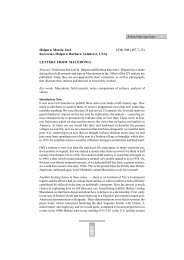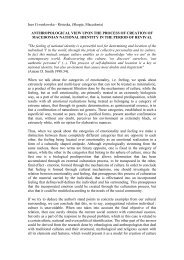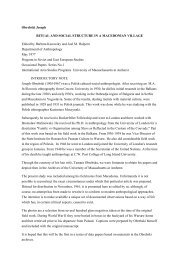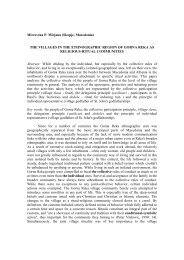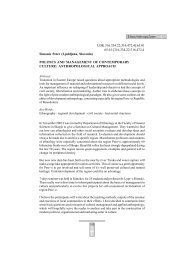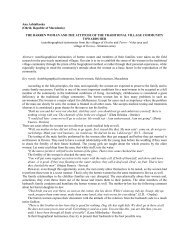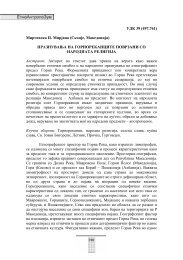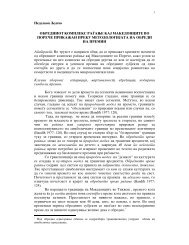Jezernik, Bozidar (Slovenia), The Red and the Black
Jezernik, Bozidar (Slovenia), The Red and the Black
Jezernik, Bozidar (Slovenia), The Red and the Black
Create successful ePaper yourself
Turn your PDF publications into a flip-book with our unique Google optimized e-Paper software.
EthnoAnthropoZoom<br />
<strong>and</strong> memories of <strong>the</strong> deceased (Anon. 1912: 3). <strong>The</strong> custom is a clear<br />
expression of Catholic tradition (Kuret 1970: III, 112). <strong>The</strong> whole of pagan<br />
Europe celebrated its festivals of <strong>the</strong> dead, <strong>and</strong> <strong>the</strong> old pagan belief in <strong>the</strong><br />
return of <strong>the</strong> spirits of <strong>the</strong> deceased later obtained Christian concept <strong>and</strong><br />
entered pure popular belief. <strong>The</strong>y still say in many places in <strong>Slovenia</strong> today<br />
that, <strong>the</strong> souls of <strong>the</strong> dead sit on <strong>the</strong> graves on All Saints Day <strong>and</strong> watch who<br />
visits <strong>the</strong>m (Kuhar 1990: 12).<br />
Facing death is always completely individual, so death is <strong>the</strong> great<br />
divider. It incites in people horror <strong>and</strong> fear because of <strong>the</strong> feeling of<br />
helplessness, since death cannot be resisted by any human means. High<br />
culture <strong>and</strong> profound wisdom are equally powerless before it. All good works<br />
<strong>and</strong> all bad works, all love <strong>and</strong> all perfidy are impotent before it.<br />
Death! You squeeze in your bony fingers all culture <strong>and</strong> wisdom, all<br />
diligence <strong>and</strong> all wickedness, all love <strong>and</strong> all perfidy – <strong>and</strong> nothing<br />
remains from all this human lumber but a pile of putrid bones <strong>and</strong><br />
dust...<br />
<strong>The</strong>re is something immense in <strong>the</strong> cult of death, <strong>and</strong> divine is <strong>the</strong><br />
thought that both king <strong>and</strong> beggar have <strong>the</strong> same last sigh. And<br />
equally great is <strong>the</strong> idea that, so to speak, brings us closer to death,<br />
which on <strong>the</strong> Feast of All Saints allows us to communicate with <strong>the</strong><br />
dead, of which <strong>the</strong> rites <strong>and</strong> ceremonies create some link between us,<br />
on whom god’s tears shine <strong>and</strong> those who sleep <strong>the</strong> eternal sleep<br />
below, without tears <strong>and</strong> dreams... And <strong>the</strong> thought is also educational<br />
that this holiday is an invaluable teacher. This cannot be denied. Death<br />
does not know us as politician, as mighty dignitary <strong>and</strong> hungry<br />
proletarian, as a member of this or that nationality <strong>and</strong> faith – death is<br />
<strong>the</strong> same for all. And anyone who thinks intelligently <strong>and</strong> with honest<br />
heart on death, will never ab<strong>and</strong>on this for <strong>the</strong>ir soul to float from<br />
poison hatred. Death divides us but most unites us… (Anon. 1914: 2-3).<br />
On <strong>the</strong> o<strong>the</strong>r h<strong>and</strong>, death is perhaps <strong>the</strong> strongest linking factor of<br />
human societies, which unites <strong>the</strong> powerless individual into a powerful<br />
community:<br />
<strong>The</strong> Feast of All Saints is thus personal <strong>and</strong> intimate, so that in places<br />
<strong>the</strong>y even call it little Christmas; <strong>the</strong> families of <strong>the</strong> deceased find<br />
each o<strong>the</strong>r by <strong>the</strong> graves, squeeze <strong>the</strong>ir h<strong>and</strong>s, chat a little, perhaps as<br />
<strong>the</strong>y haven’t for a long time. »This is <strong>the</strong> day of <strong>the</strong> great meeting«<br />
Deacon Benedetič from Solkan called <strong>the</strong> holiday (jz. 1980: 1).<br />
In <strong>the</strong> 1870s, in accordance with <strong>the</strong> spirit of nascent individualism, in<br />
Slovene towns, too, <strong>the</strong> custom developed of visiting <strong>the</strong> cemetery on <strong>the</strong> first<br />
of November <strong>and</strong> decorating <strong>the</strong> graves. People pilgrimed en masse to <strong>the</strong><br />
graves of <strong>the</strong>ir families, with artificial or live flowers <strong>and</strong> c<strong>and</strong>les, to <strong>the</strong> last<br />
resting place of <strong>the</strong>ir near <strong>and</strong> dear (Original letter 1877a: 2; Anon. 1878: 3;<br />
1893: 1; Cvetinomirski 1911: 174). Because of <strong>the</strong> powerful feelings that <strong>the</strong><br />
31




